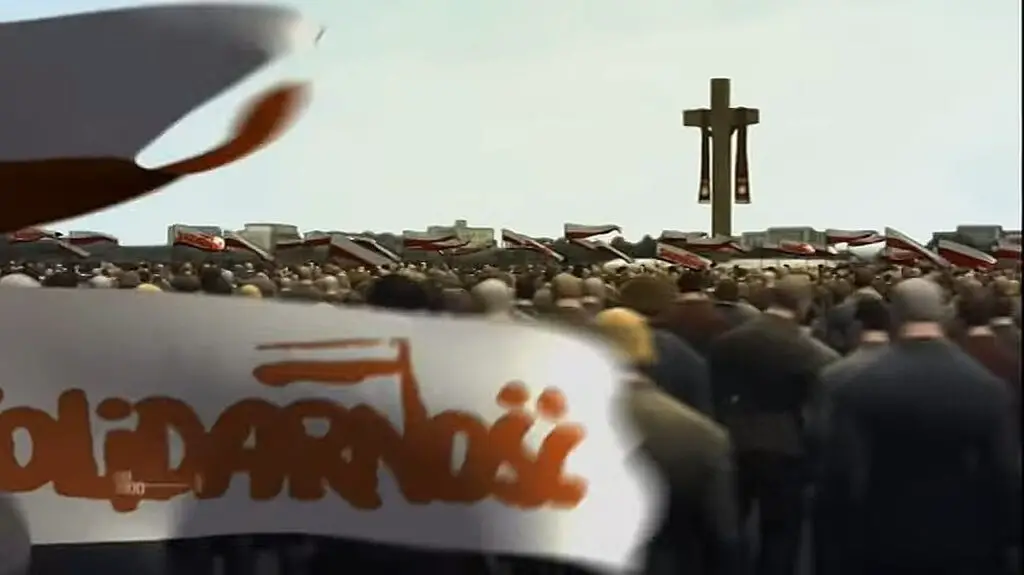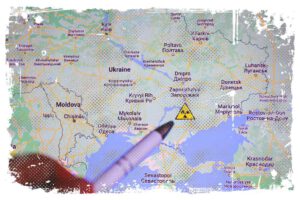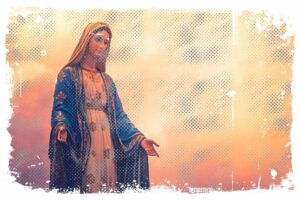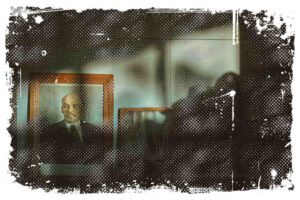Let’s face it, the history of Poland is nothing short of remarkable. It’s full of moments of immense glory and profound tragedy. It’s not easy to understand, but every Pole should, at least, be familiar with the essentials. You need to know how complex the destiny of its people has been.
The Middle Ages – The Dawn of the Polish State
Allow me to explain the beginning. Our tale commences with the baptism of Mieszko I in 966. This shift to Christianity provided an internal strength and an elevated status to Poland on the world stage.

Mieszko’s son, Bolesław Chrobry, carried on his father’s work. He met with Emperor Otto III in Gniezno in 1000. A little over two decades later, in 1025, Chrobry was crowned the first king of Poland.

But after Gniezno was invaded by the Czech prince Bretislav, Casimir the Restorer moved the royal court to Kraków in 1038. Due to many victories over German troops, Silesia and Pomerania became part of Poland in 1109.
↳ PRO TIP: Do you like traveling? Then before you buy any ticket or book an attraction, check if it's available in this worldwide Viator Database. You may save a lot of money and time. No need to thank me :)
If you want a twist, here it is – in 1226, Konrad Mazowiecki brought the Teutonic Order to Poland. Originally meant to aid in conquering the Prussians, the Teutonic Knights soon began to pose a threat to the security of Poland.
The Reign of Casimir the Great
Fast forward to 1333, when Casimir the Great took the throne. His reign was a golden era for Poland. I am convinced his contributions to the nation, such as the Wawel Castle and the establishment of the Kraków Academy (later the Jagiellonian University), have letf an indelible mark on Polish history.

Under his leadership, urban development, agriculture, mining, commerce, and craftsmanship flourished. The common saying:
“Casimir the Great found Poland wooden and left it brick”
speaks volumes about the progress during his reign. Let me tell you, he was the last ruler from the Piast dynasty.
The Union of Poland and Lithuania
In 1385, a key alliance was forged between Poland and Lithuania in Kreva, standing against the Teutonic Order. This union was solidified by the marriage of Jadwiga of Anjou and Władysław Jagiełło. Consequently, the king of the Jagiellonian dynasty led both nations.

Let’s not forget the Battle of Grunwald in 1410, one of the most significant battles of the Middle Ages. Here, the combined forces of the Polish-Lithuanian army fought against the Teutonic Order.
The Order was defeated, but it took another 56 years, until 1466, for a final peace treaty to be signed in Toruń. This was after the Thirteen Years’ War, led by Casimir IV. It is worth to say, under the peace treaty, Poland acquired Prussia and Danzig.
The Golden Age of Poland
The sixteenth century in Poland is often referred to as the golden age. From this era, many stunning examples of Renaissance architecture still stand. One key figure of this time was Nicolaus Copernicus, who, in his work “On the Revolutions of the Celestial Spheres”, put forth the revolutionary heliocentric theory – that the Earth revolves around the Sun.
Around this period, book printing surged, and the nobility had the chance to study all over Europe. Sigismund II Augustus, the last king of the Jagiellonian family, led the Union of Lublin with Lithuania in 1567. The resulting state was christened the Polish-Lithuanian Commonwealth.
What distinguished the Republic of Poland from other European countries was its unique democratic system, established in the sixteenth century. This system allowed the entire noble estate to participate in governance.
Kings were elected at electoral conventions, and religious freedom was decreed in the Polish state. This democratic setup worked smoothly for about a century. By the seventeenth century, Poland was one of the largest countries in Europe.
During Sigismund III Vasa’s reign, the capital of Poland was moved to Warsaw. His reign was also marked by years-long wars with Sweden.
In 1648, a Cossack uprising began in what is now Ukraine. This was followed by a new war with Russia, then a Swedish invasion. The wars with Russia ended with a treaty in 1667.
It is worth to say, in 1683, one of Europe’s most significant battles took place – the Battle of Vienna, or the relief of Vienna. Here, under the command of Jan III Sobieski, the Turkish expansion was halted.
Poland’s Partition Era
As the seventeenth century drew to a close, the Republic of Poland was left weakened by many wars and the accompanying epidemics. The internal situation was in crisis. Power structures were crumbling, and parliaments were being dissolved, thanks to the liberum veto principle.
Around this time, Russia began exploiting the weakened Commonwealth, meddling in its internal affairs. In 1764, Stanisław August Poniatowski ascended the throne as the last king of the Republic of Poland. He tried to bring order to the chaotic state.

In 1772, the first partition of Poland occurred, with Russia, Prussia, and Austria taking part. I think it’s worth noting that in 1791, the Great Sejm passed the first basic law in Europe, and the second in the world (after the United States Constitution) – the Constitution of May 3. This established the inheritance of the throne and abolished the liberum veto.
However, this constitution and the entire work of the Great Sejm were overturned by a Russian armed intervention. After the second partition in 1793, a fight for independence was ignited, leading to an uprising a year later under the command of Tadeusz Kościuszko with peasant participation. This uprising ended in defet, leading to the third partition. As a result, Poland disappeared from the map of Europe for 123 years.

The Struggle for Freedom
With the transition from the eighteenth to the nineteenth century came hope for Polish independence. These aspirations were tied to the military successes of Napoleon Bonaparte, who was staunchly supported by the Poles. Under Napoleon’s rule, the Duchy of Warsaw was declared as the foundation for reconstructing Poland. However, Napoleon’s defeat marked the end of these hopes.
In 1815, at the Congress of Vienna, the Kingdom of Poland was established, but it was under Russian control. In reaction to constitutional breaches, censorship, and oppression, patriotic movements sprouted.
In 1830, the November Uprising occurred, but was brutally quelled in September 1831. Soldiers and cultural figures then fled the country in a historical phenomenon known as the Great Emigration.
In 1863, the January Uprising took place. The failure of this uprising led to another wave of brutal repression, including Siberian deportation, property confiscation, death penalties, intensified Germanization and Russification, and the erasure of the Polish language from schools.
Attaining Independence
World War I brought hope for the improvement of the Polish situation, with the partitioning states landing on different sides of the conflict. It was only after the end of the Great War, on November 11, 1918, that Poland fully revived its independence. Józef Piłsudski was declared the Head of State.
During this time, Poles fought fiercely for their borders in the Greater Poland Uprising (1918-1919), the Silesian Uprisings (1919-1921), and the Battle of Warsaw, also known as the “Miracle on the Vistula” (1920).

Throughout the interwar period, the Polish state sought to structure the economic, educational, and legal situation. The March Constitution of 1921 established a parliamentary-cabinet system, and the treasury reform introduced the Polish currency.
Efforts were made to develop the Polish economy, which saw the construction of the first modern port in Gdynia in 1922, mining development in Upper Silesia, and the construction of the Central Industrial District.
Outbreak of World War II
The Molotov-Ribbentrop Pact led to the attack on Poland by Nazi Germany from the west on September 1, 1939, and by the Red Army from the east on September 17. After this defeat, Poland went under occupation.

The war years were marked by terror, mass arrests, deportations to concentration camps, mass executions, extermination of Polish intelligentsia, and the destruction of Polish property and cultural monuments.

In response, Poles fought for the liberation of their country. State authorities and the army were reformed in exile, and the Polish underground state operated within the country. Many armed organizations were established, including the Home Army (AK), which undertook intensive insurgent activities.
In 1944, Hitler attacked his former ally, the Soviet Union. This shifted Western countries’ attitudes towards the Soviet Union, who declared their readiness to aid the invaded country. This resulted in several agreements, including the Sikorski-Mayski Agreement with Poland.

The Warsaw Uprising, which erupted on August 1, 1944, was the final fight for the rights of the Republic of Poland to independence. This uprising was brutaly suppressed and Warsaw was completely destroyed. In 1945, the Red Army entered Poland.
Poland Under the Communist Regime
In February 1945, at the Yalta Conference, the US and Great Britain confirmed the incorporation of Poland’s eastern half, including Vilnius and Lviv, into the USSR. The state was under the rule of a communist dictatorship dependent on Moscow, and the government was formed by Moscow-controlled communists.

The government dominated all aspects of life, relying on terror and propaganda. From 1952, the state was officially named the Polish People’s Republic.
The majority of the population resisted the imposed communist regime and fought for their rights. Resistance often led to arrests, prison sentences, and even death sentences. Poles started mass protests against this oppressive regime – in 1956, workers in Poznań struck against the authorities, demanding improved living conditions, political and religious freedoms.
The protest was brutally suppressed. Other notable displays of rebellion included the student protests in 1968, and street demonstrations against price hikes in 1970 and 1976. All these uprisings were quelled and their participants harshly punished. This led to the formation of opposition groups that supported the repressed, published underground work, and organized independent education.
The Workers’ Defense Committee and the Movement for the Defense of Human and Citizen Rights were the most notable of these groups.
On October 16, 1978, Cardinal Karol Wojtyla was elected Pope and took the name John Paul II. His teachings on the protection of life, individual dignity, and the importance of the church sparked hope among his compatriots.
His first pilgrimage to his homeland was a pivotal event that significantly influenced the spiritual rejuvenation of Poles. This resulted in societal changes – Poles’ national identity strengthened and the ruling communist authorities faced increasing criticism.
The Rise of “Solidarity”
In 1980, the birth of the Independent Self-governing Trade Union “Solidarity” and a wave of strikes against the deteriorating economic situation marked the final phase of the fight for a democratic Poland.

Lech Wałęsa, leader of the August strike at the Gdańsk Shipyard, led this movement. “Solidarity” gained swift support and its activities stirred hope among Poles, advocating for freedom, justice, the common good, and human dignity.
The First National Congress of Delegates of NSZZ “Solidarność”, referred to as the Congress of Free Poland, was a milestone event.
From the start, the communist authorities plotted to destroy Solidarity, pushed by the Soviet Union. On December 13, 1981, Wojciech Jaruzelski implemented martial law. Curfews were imposed, civil rights were curtailed, telephones were disconnected, and tanks rolled onto the streets.
All organizations except the Communist Party were suspended under the threat of internment and the death penalty. Despite this, strikes erupted across the country, but were brutally suppressed.
Yet, the “Solidarity” spirit endured. Underground structures of “Solidarity” kept operating, and underground student organizations, political parties, press, and radio stations thrived. Many of these activities found refuge within the Church. In 1983, Lech Wałęsa’s efforts were recognized with the Nobel Peace Prize.
As the country’s economic and social situation worsened, the authorities offered the opposition round table talks and permitted free elections.
Path to Freedom and Democracy
Tadeusz Mazowiecki became the first non-communist prime minister of Poland. In 1990, Lech Wałęsa won the presidential election, and finally, Poland returned to the community of free and democratic nations. This incredible journey from oppression to freedom, I think it’s worth saying, is a testament to the resilience and tenacity of the Polish people.

If you ever visit Poland, I think you’ll want to remember this story, to truly appreciate the hard-won freedom and vibrant democracy you see today. The streets, buildings, and faces all carry the marks of this struggle. It’s a story of courage and perseverance that should inspire all of us.
Today’s Poland – A Symbol of Freedom
Imagine, in a mere blink of history, Poland spurred the downfall of communist systems across Central and Eastern Europe. What started in Poland was a domino effect, toppling dictatorial governments in Hungary, East Germany, Czechoslovakia, Bulgaria, and Romania. By 1991, the once-mighty Soviet Union collapsed.
Poland, a symbol of resilience, found its place on the global stage. In 1999, it joined NATO, and by 2004, it became a member of the European Union. These milestones symbolize the reentry of the Polish state to the Western world.
I believe it’s important to remember how quickly Poland transformed. If you were there, you’d see the scars of the past but also the unmistakable signs of growth, hope, and unity. Poland is a testament to the power of people who never lose sight of freedom, even when it seems impossible.
Key Dates From Polish History
If you need a quick overview of Poland’s journey, here are the most important dates from Polish history:
Allow me to present some key moments that shaped the Polish nation:
- 966 – Baptism of Poland, marks the start of Polish statehood.
- 972 – Battle of Cedynia, a Polish victory over Germany.
- 1000 – Congress in Gniezno, an important meeting between German Emperor Otto III and Bolesław Chrobry.
- 1002-1018 – Polish-German War, initiated by Bolesław Chrobry, culminating with the capture of Milsko and Lusatia.
- 1025 – Coronation of Bolesław Chrobry, full independence for the Polish state.
- 1138 – Division of Poland into districts, leading to a weakened state.
- 1226 – The Teutonic Knights arrive in Poland, brought by Konrad, Duke of Masovia.
A Struggle for Independence and Unity
- 1241 – Tatar invasion, Battle of Legnica, Polish defeat, and subsequent Mongol march to Hungary.
- 1327 – Start of the war with the Teutonic Order, instigated by Poland to reclaim Mazovia.
- 1331 – Battle of Płowce, where the army of Władysław I the Elbow-high defeats the Teutonic Knights.
The list goes on and on. I think it’s worth saying that these events marked not just Poland’s struggles but its resilience and eventual triumphs as well. As an observer, you might find some of these events heart-wrenching, others uplifting. But one thing’s for sure: the spirit of Poland can’t be subdued.
- 1335 – Congress in Visegrad involves monarchs of Bohemia, Hungary, and Poland, aimed at settling disputes with the Teutonic Knights.
- 1343 – Peace in Kalisz, the Teutonic Order becomes dependent on Poland.
- 1385 – Polish-Lithuanian Union, commencement of close cooperation between Poland and Lithuania.
- 1410 – Battle of Grunwald, a victory for Polish and Lithuanian troops against the Teutonic Knights.
A Series of Wars, Agreements, and Political Transformations of Poland
This saga of the Polish history continues with various wars, agreements, and political transformations. Being there, you need to know that each of these dates represents a major shift, a turning point, or a decisive moment in the story of Poland:
- 1411 – Peace of Toruń, ending the Polish-Teutonic War 1409-1411.
- 1431-1435 – Polish-Teutonic War, concluding with a victorious peace of Brześć Kujawski for Poland.
- 1444 – Battle of Varna, defeat of Polish-Hungarian forces against Turkey, death of King Władysław of Varna.
- 1454 – 1466 – Thirteen Years’ War with the Teutonic Order.
- 1454 – 1466 – Thirteen Years’ War with the Teutonic Order. This war, in particular, was a significant chapter in Polish history, and I believe it’s essential to mention its resolution:
- 1466 – Second Peace of Toruń, which led to the downfall of the Teutonic Knights as a major European power.
The Last Teutonic War and Union with Lithuania
- 1519 – 1521 – The last war of the Teutonic Order with Poland.
- 1525 – Prussian Homage, a momentous event when Albrecht Hochenzollern pays homage to King Sigismund I the Old of Poland.
- 1569 – Union of Lublin with Lithuania, giving birth to the Polish-Lithuanian Commonwealth, a significant political and historical development.
- 1570 – Sandomierz Agreement, a pact between Lutherans, Calvinists, and Czech Brethren.
- 1573 – Warsaw Confederation, marking the start of legally guaranteed religious tolerance.
- 1573 – First free election, with Henry of Valois being elected King of Poland.
Poland’s Struggles and Victories
From 1596, there were moments of both strife and victory. I am convinced that these events are integral parts of the Polish story:
- 1596 – Union of Brest, the merging of the Orthodox Church with the Latin Church in the Polish-Lithuanian Commonwealth.
- 1600 – The start of the war with the Swedes, a struggle for the Swedish throne between Charles of Suderman and Sigismund III Vasa, over Inflant.
And so it goes, every date another turning point, every event another chapter in the story of Poland. I can tell that the pattern continues, with battles fought, peace treaties signed, and territories lost and regained. It is worth saying, if you want to undrstand Poland, you need to dive deep into these historical events.
- 1605 – Battle of Kircholm, a remarkable victory for Polish and Lithuanian troops over the Swedish army with hussars.
- 1622 – Truce with the Swedes in Mitawa, ending the war with Sweden over Inflant.
- 1629 – Peace of Altmark, a six-year truce between Sweden and the Polish-Lithuanian Commonwealth.
- 1609 – 1618 – Polish–Russian War, a significant event that saw Polish troops march into Moscow.
- 1620 – 1699 – Polish–Turkish Wars, a series of conflicts ended with the defeat of Turkey by the army of Jan III Sobieski.
- 1620 – Defeat at Cecora, where Polish troops faced the Turkish-Tatar army.
- 1621 – Battle of Chocim, where the army of the Polish-Lithuanian Commonwealth tasted victory over the Turkish army of Sultan Osman II.
Turkish Invasion and Subsequent Victories
- 1672 – Turkish invasion of Poland, with the capture of Kamieniec Podolski by the Turks.
- 1673 – Victory at Chocim, where the Crown and Lithuanian armies managed to defeat the Turkish army.
- 1683 – Relief of Vienna, a victory of Austrian, German, and Polish troops, stopping the Turks from further conquest of Western Europe.
- 1699 – Peace of Karłowice, a treaty that ended the war between the countries of the Holy League and the Ottoman Empire.
- 1717 – The silent Sejm was established to pu an end to the king’s struggle with the nobility.
Confederation and Partition of Poland
- 1768 – 1772 – Bar Confederation was formed, which unfortunately became a pretext for the partition of Poland.
- 1772 – First Partition of Poland by Russia, Austria, and Prussia, beginning a dark chapter in the country’s history.
- 1788 – 1792 – The Four-Year (Great) Sejm was convened, aimed at restoring sovereignty and accelerating the economic development of the Republic of Poland.
- 1791 – Adoption of the Constitution of May 3, an important step that marked the first in Europe and the second in the world, after the USA.
Alright, let’s break it down for you, and I’ll be sure to keep it simple and straightforward.
Late 18th and Early 19th Century
- 1792 – Targowice Confederation forms, aiming to topple the Constitution of May 3.
- 1793 – Russia and Prussia enact the Second Partition of Poland.
- 1794 – Kościuszko Uprising occurs, resulting in a Polish victory at the Battle of Racławice.
- 1795 – The Third Partition of Poland happens by Russia, Austria, and Prussia.
- 1797 – Polish Legions in Italy rise, initiated with Napoleon’s approval.
Towards the 20th Century
- 1807 – Duchy of Warsaw comes into being, a surrogate for the Polish state.
- 1816 – Kingdom of Poland established, which stays under the Russian Empire until 1918.
- 1830 – November Uprising erupts against Russia, sadly ending in defeat.
- 1846 – Kraków Uprising breaks out, also ends in defeat, leading to the end of the Free City of Kraków.
- 1863 – January Uprising breaks loose; its suppression results in severe Russian repression.
World War I
- 1914 – 1918 – World War I unfolds, the biggest armed conflict in Europe since Napoleon.
- 1918 – Poland regains independence on November 11, after 123 years of partitions.
- 1918 – Polish women gain voting rights and can also run for election.
- 1918–1919 – Greater Poland Uprising takes place, allowing Greater Poland to merge with the reviving Polish state.
The Early 20th Century Struggles
- 1919 – Adoption of the Small Constitution establishes a committee government in Poland.
- 1919–1921 – Silesian Uprisings occur as three armed conflicts in Upper Silesia.
- 1919 – 1921 – Polish–Soviet War happens, a conflict between newly reborn Poland and Soviet Russia.
- 1920 – The Battle of Warsaw, known as the Miracle on the Vistula takes place.
- 1921 – Treaty of Riga sets up the boundaries of Poland.
World War II
- 1921 – March Constitution, the first modern Polish Constitution, gets adopted.
- 1926 – Marshal Józef Piłsudski conducts the May Coup.
- 1939 – Germany breaks the non-aggression pact with Poland, marking the start of World War II.
- 1939 – Soviet Union attacks Poland as part of a secret pact with Germany.
- 1939 – 1945 – Polish Underground State operates as the only such entity in Europe.
- 1940 – The Soviets commit the Katyn Massacre on Polish prisoners of war.
- 1943 – Warsaw Ghetto Uprising happens, a Jewish resistance against the Germans.
- 1944 – Warsaw Uprising begins, ending with Warsaw’s total annihilation.
- 1945 – End of World War II and start of Communist rule in Poland, with Yalta Conference and Potsdam Conference.
The Iron Grip of Communism
- 1947 – 1956 – Poland undergoes the Stalinist period, characterized by severe repression and terror.
- 1980 – Creation of NSZZ “Solidarność”, a key opposition force against the government.
- 1981 – Martial law introduced in Poland to suppress the Solidarity movement.
Poland’s Current Times
- 1989 – Round Table Discussions mark the end of communism in Poland.
- 1999 – Poland formally joins NATO.
- 2004 – Poland enters the European Union.
- 2010 – The Smolensk crash claims the lives of President Lech Kaczyński, his wife, and 94 other passengers.
References:
- https://pl.wikipedia.org/wiki/Historia_Polski
- https://dzieje.pl/
- https://ciekawostkihistoryczne.pl/category/miejsce/polska/
- https://bliskopolski.pl/historia-polski/w-pigulce/



